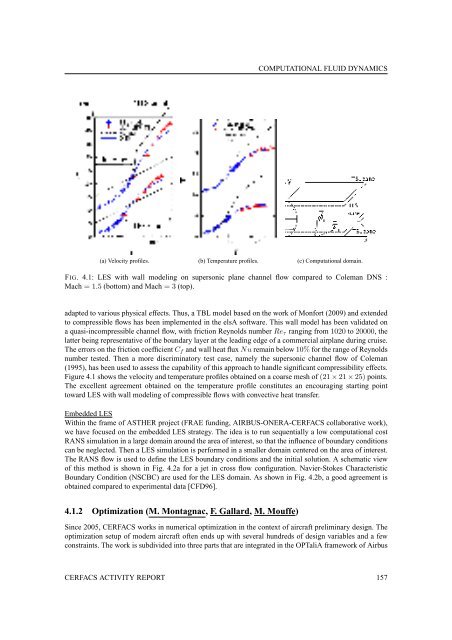CERFACS CERFACS Scientific Activity Report Jan. 2010 â Dec. 2011
CERFACS CERFACS Scientific Activity Report Jan. 2010 â Dec. 2011
CERFACS CERFACS Scientific Activity Report Jan. 2010 â Dec. 2011
Create successful ePaper yourself
Turn your PDF publications into a flip-book with our unique Google optimized e-Paper software.
COMPUTATIONAL FLUID DYNAMICS<br />
(a) Velocity profiles. (b) Temperature profiles. (c) Computational domain.<br />
FIG. 4.1: LES with wall modeling on supersonic plane channel flow compared to Coleman DNS :<br />
Mach = 1.5 (bottom) and Mach = 3 (top).<br />
adapted to various physical effects. Thus, a TBL model based on the work of Monfort (2009) and extended<br />
to compressible flows has been implemented in the elsA software. This wall model has been validated on<br />
a quasi-incompressible channel flow, with friction Reynolds number Re τ ranging from 1020 to 20000, the<br />
latter being representative of the boundary layer at the leading edge of a commercial airplane during cruise.<br />
The errors on the friction coefficient C f and wall heat flux Nu remain below 10% for the range of Reynolds<br />
number tested. Then a more discriminatory test case, namely the supersonic channel flow of Coleman<br />
(1995), has been used to assess the capability of this approach to handle significant compressibility effects.<br />
Figure 4.1 shows the velocity and temperature profiles obtained on a coarse mesh of (21 × 21 × 25) points.<br />
The excellent agreement obtained on the temperature profile constitutes an encouraging starting point<br />
toward LES with wall modeling of compressible flows with convective heat transfer.<br />
Embedded LES<br />
Within the frame of ASTHER project (FRAE funding, AIRBUS-ONERA-<strong>CERFACS</strong> collaborative work),<br />
we have focused on the embedded LES strategy. The idea is to run sequentially a low computational cost<br />
RANS simulation in a large domain around the area of interest, so that the influence of boundary conditions<br />
can be neglected. Then a LES simulation is performed in a smaller domain centered on the area of interest.<br />
The RANS flow is used to define the LES boundary conditions and the initial solution. A schematic view<br />
of this method is shown in Fig. 4.2a for a jet in cross flow configuration. Navier-Stokes Characteristic<br />
Boundary Condition (NSCBC) are used for the LES domain. As shown in Fig. 4.2b, a good agreement is<br />
obtained compared to experimental data [CFD96].<br />
4.1.2 Optimization (M. Montagnac, F. Gallard, M. Mouffe)<br />
Since 2005, <strong>CERFACS</strong> works in numerical optimization in the context of aircraft preliminary design. The<br />
optimization setup of modern aircraft often ends up with several hundreds of design variables and a few<br />
constraints. The work is subdivided into three parts that are integrated in the OPTaliA framework of Airbus<br />
<strong>CERFACS</strong> ACTIVITY REPORT 157
















